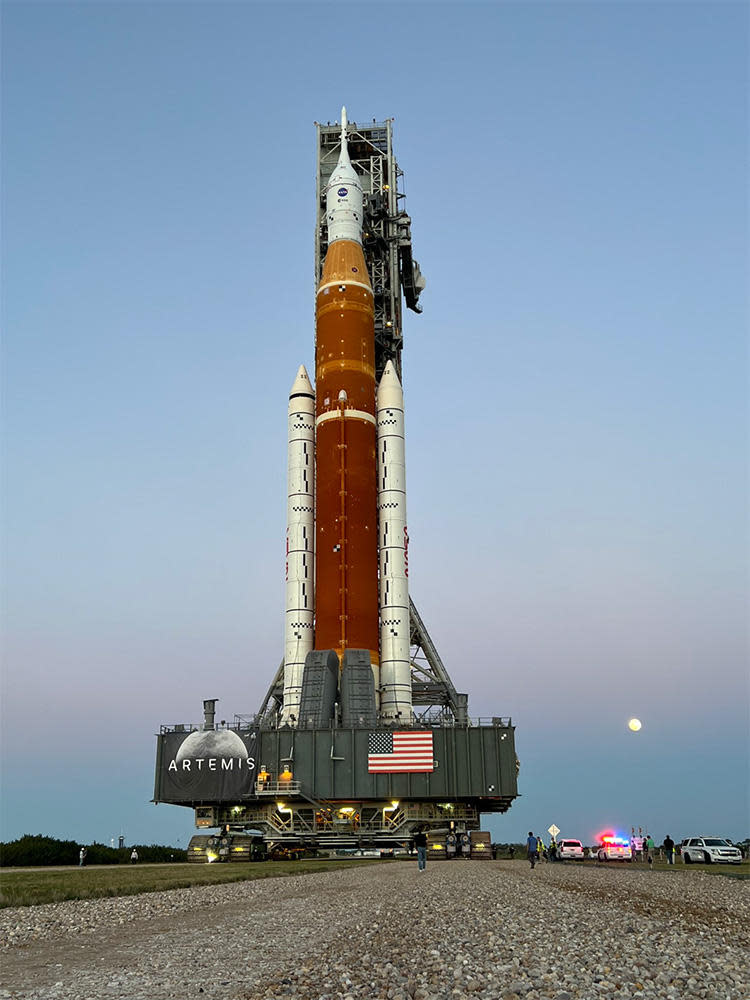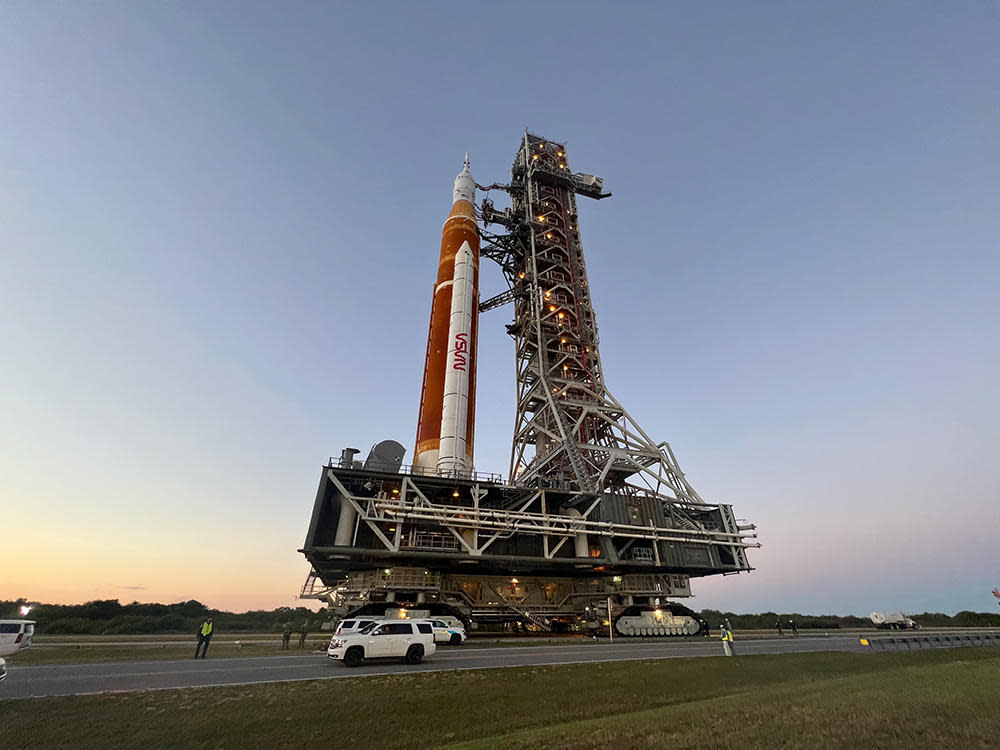NASA's new moon rocket rolled out to launch pad for dress rehearsal
NASA's new SLS moon rocket, the most powerful in agency history, was rolled out to launch pad 39B at the Kennedy Space Center overnight Thursday for a dress-rehearsal countdown that will set the stage for its long-awaited maiden flight early this summer.
The 322-foot-tall rocket, anchored to a 10-million-pound mobile launch gantry atop a massive crawler-transporter, began inching its way out of High Bay 3 in the cavernous Vehicle Assembly Building at 5:47 p.m. EDT Thursday amid cheers and applause from a throng of dignitaries, NASA workers and their families.
"Ladies and gentlemen, the world's most powerful rocket, ever, right here!" said NASA Administrator Bill Nelson, pointing to the towering Space Launch System — SLS — rocket just behind him. "And it's back to the moon and then on to Mars!"

The crawler, burning up a gallon of diesel fuel every 32 feet at a top speed of 0.8 mph, completed the 4.2-mile trip to the pad at 4:30 a.m. Friday.
The rocket's maiden flight, the first mission in NASA's Artemis moon program, "will pave the way for humanity's giant leap, future missions to Mars," Nelson said. "There's no doubt that we are in a golden era of human space exploration, discovery and ingenuity in space. And it all begins with Artemis 1."
The unpiloted test flight, expected in late May or, more likely, June, will carry three instrumented mannequins beyond the moon and back to a Pacific Ocean splashdown to pave the way for the first piloted Artemis mission in 2024.
"When this monster rocket lifts off, it will carry all of our greatest hopes in the heavens," Nelson said. "I want to thank all of you, all of these workers, the whole space team ... may God bless you."
Fittingly, a full moon began rising shortly after rollout began, followed by a spectacular southwest-to-northeast pass by the International Space Station as if showing the way to pad 39B.
With the rocket and its mobile launch platform now "hard down" at pad, engineers will work through a series of tests culminating in a "wet dress-rehearsal" April 1-3 that will mimic launch day procedures. The SLS will be loaded with liquid hydrogen and oxygen propellants in a countdown that will tick to within a few seconds of zero.

The rocket then will be hauled back to the VAB for servicing and then back out to the pad for launch on the Artemis 1 mission.
Years behind schedule and billions over budget, the Space Launch System rocket is the most powerful in agency history, eclipsing even the legendary Saturn 5 that carried Apollo astronauts to the moon more than 50 years ago.
Equipped with four upgraded space shuttle main engines and two extended solid-fuel boosters, the SLS will tip the scales at 5.75 million pounds when loaded with propellant, producing 8.8 million pounds of thrust at liftoff. The Saturn 5 generated 7.5 million pounds of push.
NASA says the SLS in its initial "block 1" configuration can deliver nearly 30 tons of payload to the moon in a single flight. Future variants, with a more powerful upper stage and strap-on boosters, will be able to deliver nearly 50 tons directly to the moon. None of the stages or boosters are designed for recovery.
SpaceX's planned Starship, made up of two fully reusable stages, will be more powerful than even the SLS, generating a staggering 17 million pounds of thrust at liftoff.
The company hopes to launch an unpiloted test flight to low-Earth orbit and back in the next few months. For missions to the moon, SpaceX says the Starship will be able to deliver around 100 tons of payload, but the rocket will require re-fueling by multiple Starship "tankers" before departing Earth orbit.

While it can carry less and cannot be reused, the SLS does not require refueling. In its initial test flight, the rocket will propel its Orion crew capsule directly into an orbit carrying it well beyond the moon. The capsule then will return to Earth for a high-speed — and high temperature — re-entry and splashdown in the Pacific Ocean.
The flight is intended to test the hardware and procedures for piloted missions and if all goes well, NASA hopes to launch four astronauts on an around-the-moon flight in 2024.
That mission, in turn, will set the stage for a flight to rendezvous with a Starship upper stage in 2025 or shortly thereafter. After transferring into the "Human Landing System" spacecraft, built under contract to NASA, the first woman and the first person of color will descend to a landing near the moon's south pole.
But the schedule is ambitious and funding is uncertain, despite widespread bipartisan support. NASA's Office of Inspector General concluded in November 2021 that "NASA is projected to spend $93 billion on the Artemis effort up to FY 2025."
"We also project the current production and operations cost of a single SLS/Orion system at $4.1 billion per launch for Artemis (flights) 1 through 4, although the agency's ongoing initiatives aimed at increasing affordability seek to reduce that cost."
It's not yet known what it might cost to launch a stand-alone Starship moon mission preceded by four to eight tanker flights.
Zanny Minton Beddoes on the global economic fallout from Russia's war in Ukraine
Friends reveal how early they predicted Ketanji Brown Jackson would serve on the Supreme Court
